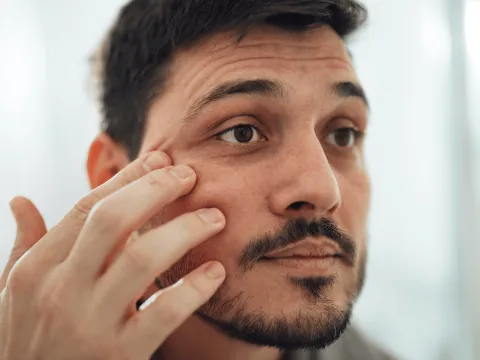- UChicago Medicine AdventHealth
- and Cristina O'Donoghue, MD, MPH

Choose the health content that’s right for you, and get it delivered right in your inbox.
If you regularly check your arms, legs and face for signs of skin cancer, you’ve taken a step in the right direction. You’re halfway there to ensure you spot any sign of skin cancer early.
But skin cancer can develop in places on your body you might not expect — even in areas that don’t get much sun. Our UChicago Medicine AdventHealth experts are here to advise you on some of the hard-to-spot areas where skin cancer can hide.
Cristina O’Donoghue, MD, MPH, is a UChicago Faculty Physician who is board-certified in surgical oncology. She is dedicated to providing individualized care to her patients and has extensive experience in managing complex cancer conditions, including melanoma. Dr. O’Donoghue breaks down how to best protect yourself below.
Your Eyes and Eyelids
Dr. O’Donoghue advises the best way to look for skin cancer near your eyes is to keep a close watch on any new or growing spots around your eyelids. Tell your doctor if you notice any changes in the shape or size of your pupil, or dark spots in the colored iris around your pupil.
As far as your vision is concerned, cancer can cause blurry or spotty vision. One of the best ways to protect your eyes from developing melanoma is to wear sunglasses that protect you from ultraviolet (UV) rays. Don’t forget your eyelids when you’re applying sunscreen.
Your Scalp
“If your hair is lighter in color, thinning or if you have a bald spot, you’re at a higher risk for developing skin cancer on your scalp. However, even if you have dark, thick hair, you could still experience sun damage,” says Dr. O’Donoghue. Wearing a hat is the best way to prevent sun exposure to your scalp. You can also carefully apply sunscreen to those areas. Look for any new, bleeding or changing spots on your scalp when you’re checking for skin cancer.
Under a Tattoo
The ink on colorful tattoos can often make it hard to see whether skin cancer is growing underneath. Remember to always cover your tattoos with sunscreen, too.
Under Fingernails or Toenails
While skin cancer under a nail is rare, it’s still possible and most likely to occur under the nail on your thumb or big toe. You may mistake it for a bruise that isn’t healing. If you often wear nail polish, you should periodically remove it to check that nothing is developing underneath.
Between Your Toes
“We know that most people probably don't spend much time carefully checking between their toes. However, skin cancers can form in those tucked-in areas and grow more concerning the longer they go unnoticed,” says Dr. O’Donoghue. Apply sunscreen between your toes — especially when lying in the sun for a while.
Physical vs. Chemical Sunscreen
People use two types of sunscreens to protect themselves from the sun: physical and chemical. Let’s take a closer look at each.
Physical Sunscreen
Physical sunscreens, more commonly known as mineral sunscreens, create a physical barrier on the skin that shields it from the sun.
These sunscreens deliver broad-spectrum protection by reflecting radiation away from your skin. They also help ward off UVA-related skin damage, including dark patches and wrinkles.
The only downside is that they can be difficult to spread and leave your skin looking white, but your health is worth the extra effort. Be sure to reapply as needed because physical sunscreens aren’t always water-resistant.
Chemical Sunscreen
Chemical sunscreens, on the other hand, are like sponges. They don’t sit on the skin or block rays. Instead, they feature active ingredients that absorb UV rays before your skin can soak them up. These chemical UV filters include:
- Avobenzone
- Homosalate
- Octinoxate
- Octisalate
- Octocrylene
- Oxybenzone
In most cases, chemical sunscreens don’t leave a visible film layer on the skin, which makes them easier to wear on a broader range of skin tones.
Most people prefer chemical sunscreens because they’re easier to apply and wear. Chemical sunscreens are designed for absorption, so they tend to go on smoothly without feeling sticky or greasy, and they don’t leave the telltale white cast as physical sunscreen does.
Remember, you should apply one ounce of sunscreen to your body every time you go out in the sun.

Schedule Your Skin Cancer Screening
Skin care is often overlooked as part of healthcare, but it’s important to make it a priority. Early skin cancer detection gives you the greatest likelihood of successful treatment.
Have you noticed any worrisome changes to your skin? It’s better to be proactive in your health to ensure your long-term well-being. Call Call630-216-4861 today for more information or to schedule an appointment with Dr. O’Donoghue.

